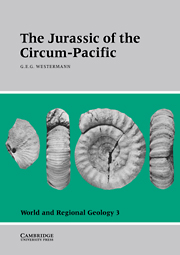Book contents
- Frontmatter
- Contents
- List of contributors
- Preface
- Acknowledgments
- Introduction
- Part I Time scales
- 1 Numerical time scale in 1988
- 2 Jurassic magnetic-polarity time scale
- Part II Circum-Pacific base map
- Part III Regional geology and stratigraphy
- Part IV Biochronology
- Part V Biogeography
- Part VI Climatology and oceanography
- Appendix: Biochronology and atlas with index and guide fossils
- General Index
- Index of Guide- and Indexfossils
1 - Numerical time scale in 1988
Published online by Cambridge University Press: 04 August 2010
- Frontmatter
- Contents
- List of contributors
- Preface
- Acknowledgments
- Introduction
- Part I Time scales
- 1 Numerical time scale in 1988
- 2 Jurassic magnetic-polarity time scale
- Part II Circum-Pacific base map
- Part III Regional geology and stratigraphy
- Part IV Biochronology
- Part V Biogeography
- Part VI Climatology and oceanography
- Appendix: Biochronology and atlas with index and guide fossils
- General Index
- Index of Guide- and Indexfossils
Summary
Introduction
The numerical time scale is an important tool for geologists, but often such scales are based on a minimal amount of data. The problem is particularly acute for Jurassic time; this problem results from the unavoidable constraint that a realistic numerical time scale must be derived from appropriate radiometric measurements. These measurements can be undertaken only with adequate geochronometers, in which the Jurassic sequence is particularly lacking. Adequate geochronometers consist of stratigraphically well controlled (within a stage) potassium-or uranium-bearing minerals or rocks. This stratigraphic constraint eliminates most plutonic rocks, leaving only volcanics or glauconitic sediments as sources for precise geochronological tie points. However, where few data are available, plutonic rocks are useful because they are easily dateable and their mineral fractions frequently are better preserved than those of volcanic rocks.
Because of the limited number of adequate control points along the sequence, usually it is necessary to interpolate between these geochronologically founded tie points in order to suggest numbers for stage boundaries. An abundant recent literature proposes many new suggestions for interpolation; but the difficult task of establishing and qualifying valid tie points is rarely undertaken. Often, the examination of the geochronological data is given a minor treatment in papers dealing with time-scale calibration, when it should be the foundation.
- Type
- Chapter
- Information
- The Jurassic of the Circum-Pacific , pp. 3 - 11Publisher: Cambridge University PressPrint publication year: 1993



